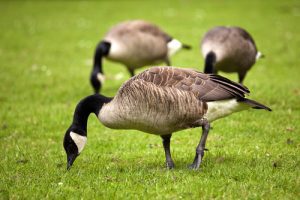Canada Geese – Our New Resident Pest
By Chris Williams on January 20, 2012.
Used to be that Canada geese were welcome winter visitors. We wistfully watched them take off on their migratory flight come spring. But over the years, many Canada geese have changed their habits and no longer migrate. These resident geese have discovered that they like the suburban lifestyle: plenty of food and almost no predators. Who needs that exhausting migratory flight anyway?
Canada geese have become year-round residents of golf courses, city parks, sports fields, even private lawns—any place with manicured grass and nearby water. Homeowners who live on a lake or other body of water are especially likely to have uninvited geese on their lawns. Likewise, office complexes, golf courses, parks or other sites that have an ornamental pond or lake on the grounds can become a permanent home to Canada geese. A lake provides food, nest sites, protection from predators, and a takeoff and landing strip. A nearby lawn provides a convenient feeding and loafing site.
You may think it would be lovely to have a flock of geese on your front lawn, but ask anyone who has had to deal with them. Resident geese cause serious problems for turf grass managers and landscapers. Not only do the geese leave piles of droppings (about 1/4 pound per goose per day), but they foul ponds and root holes in the turf two or three inches deep. They can be loud and aggressive when defending the nest or their young.
 It’s rather ironic that these nonmigratory Canada geese are protected by federal law under the Migratory Bird Treaty Act. To kill these geese outside of the legal hunting season or to capture them requires a federal, and in some cases, a state permit. Some states have separate hunting seasons for nonmigratory geese. A federal permit is not required to scare, herd, or repel Canada geese provided they are not injured or confined.
It’s rather ironic that these nonmigratory Canada geese are protected by federal law under the Migratory Bird Treaty Act. To kill these geese outside of the legal hunting season or to capture them requires a federal, and in some cases, a state permit. Some states have separate hunting seasons for nonmigratory geese. A federal permit is not required to scare, herd, or repel Canada geese provided they are not injured or confined.
There are a number of different ways to manage resident Canada geese, no one of them totally effective. Chemical taste repellents are sprayed onto the grass that geese eat. An irritant repellent burns their feet if they walk on it. Decoys, noisemaking cannons, firecrackers, flags, water hoses, streamers, mylar balloons, laser guns, and chase dogs are all used to harass or scare geese away from a site. Birth control methods include nest destruction, egg addling, and contraceptive bait.
The best permanent control for resident Canada geese is “habitat modification.” Habitat modification simply means changing surroundings so that they are not so attractive to geese. Since geese, grass and water go together, steps that are taken to make this connection more difficult for the geese will discourage them.
Geese like to feed and loaf in areas where they have an open, unobstructed view of what’s around them, especially the water. Waterfront homeowners can plant trees, dense shrubs, a shoreline hedge, or a buffer of tall native grasses that will reduce the geese’s line-of-sight to the water and their easy access to the water. Leave a winding pathway through the plantings to the shore for people. You can also create a step barrier at the water’s edge instead of leaving a gradual slope from the lawn to the water. All of this will make the property less attractive to geese.
Decorative fences can protect sidewalks or grassed-in areas. A pond or grassy area can be protected with a chicken wire fence at the water’s edge. Monofilament lines can be strung to keep geese out of areas. Be sure to flag the lines so people and pets can see them. Fencing is most effective in small spaces, or during the period when the geese are molting and are flightless. To keep out walking Canada geese, a fence must be at least two feet high.
Geese love to eat well manicured, tender young grasses. Simply letting lawns grow taller and fertilizing and watering them less will also make the site less attractive to geese.